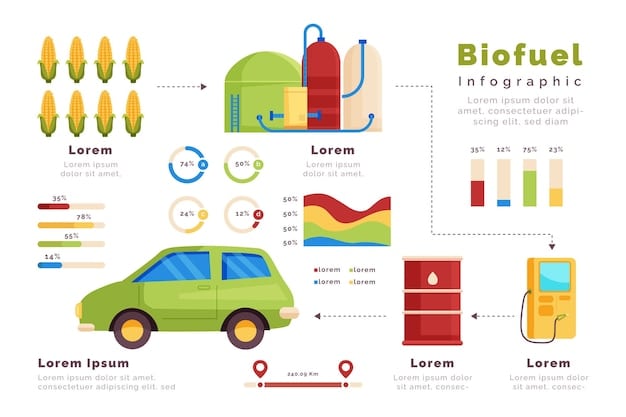Oil Change Intervals: Conventional vs. Synthetic Oil Explained

Oil change intervals depend on the type of oil used, with conventional oil typically requiring changes every 3,000 to 5,000 miles, while synthetic oil can often extend to 7,500 to 10,000 miles or more due to its enhanced properties and resistance to degradation.
Understanding the optimal oil change intervals is crucial for maintaining your vehicle’s health and longevity. The type of oil you use, whether conventional or synthetic, significantly impacts how often you need to schedule this essential service. Let’s delve into the key differences and determine the best approach for your car.
Understanding Conventional Oil Change Intervals
Conventional oil has been the standard lubricant for engines for many years. It’s derived directly from crude oil and offers adequate protection for many vehicles. However, its properties differ significantly from synthetic oils, leading to different oil change intervals.
So, how often should you change your conventional oil?
Typical Mileage for Conventional Oil Changes
Generally, conventional oil requires more frequent changes compared to synthetic options.
- Standard Recommendation: Most manufacturers recommend changing conventional oil every 3,000 to 5,000 miles.
- Driving Conditions: This interval can vary based on driving habits and conditions. For example, frequent short trips, stop-and-go traffic, and extreme temperatures can shorten the interval.
- Vehicle Age: Older vehicles may also require more frequent oil changes, as their engines might be less efficient and prone to oil leaks.
Factors Affecting Conventional Oil Change Frequency
Several factors can influence how often you need to change your conventional oil.
- Severe Driving Conditions: These include towing heavy loads, off-roading, and racing. These activities put extra stress on the engine and oil.
- Environmental Factors: Dusty or dirty environments can contaminate the oil more quickly, necessitating more frequent changes.
- Manufacturer’s Recommendations: Always consult your vehicle’s owner’s manual for specific recommendations.
It’s important to monitor your driving habits and environmental conditions to determine the most appropriate oil change interval for your vehicle when using conventional oil. Regular checks can help prevent engine damage and maintain optimal performance.
Exploring Synthetic Oil Change Intervals
Synthetic oil is engineered to provide superior performance and protection compared to conventional oil. It’s made through a more complex refining process, resulting in enhanced properties and extended oil change intervals.
Let’s examine why synthetic oil allows for longer intervals between changes.

Benefits of Synthetic Oil for Extended Intervals
- Enhanced Stability: Synthetic oil is more resistant to breakdown and oxidation at high temperatures.
- Improved Lubrication: It provides better lubrication, reducing friction and wear on engine components.
- Better Cold-Start Performance: Synthetic oil flows more easily at low temperatures, offering better protection during cold starts.
- Reduced Sludge Buildup: It minimizes the formation of sludge and deposits, keeping the engine cleaner.
Typical Mileage for Synthetic Oil Changes
Synthetic oil can significantly extend the time between oil changes.
- Standard Recommendation: Most manufacturers recommend changing synthetic oil every 7,500 to 10,000 miles.
- Extended Performance: Some advanced synthetic oils can even last up to 15,000 miles or more, depending on the vehicle and driving conditions.
- Oil Life Monitoring Systems: Many modern vehicles have oil life monitoring systems that adjust the oil change interval based on actual driving conditions and oil quality.
Synthetic oil offers numerous advantages, including extended oil change intervals, which can save you time and money in the long run. However, it’s crucial to follow your vehicle’s manufacturer recommendations and monitor the oil’s condition to ensure optimal engine protection.
Comparing Conventional and Synthetic Oil: Key Differences
Choosing between conventional and synthetic oil involves understanding their distinct properties and performance characteristics. These differences directly impact oil change intervals and overall engine health.
Here’s a detailed comparison to help you make an informed decision.
Performance and Protection
Synthetic oil generally outperforms conventional oil in several key areas.
- High-Temperature Stability: Synthetic oil maintains its viscosity and protective properties at higher temperatures, preventing engine damage.
- Low-Temperature Flow: It flows more easily at low temperatures, ensuring better lubrication during cold starts.
- Oxidation Resistance: Synthetic oil is more resistant to oxidation, which can lead to sludge formation and reduced oil life.
Cost and Availability
While synthetic oil offers superior performance, it also comes at a higher cost.
- Price Difference: Synthetic oil is typically more expensive than conventional oil.
- Availability: Both types of oil are widely available at auto parts stores and service centers.
- Long-Term Savings: The extended oil change intervals of synthetic oil can offset the higher upfront cost over time.
The choice between conventional and synthetic oil depends on your vehicle’s requirements, driving habits, and budget. Synthetic oil provides enhanced protection and longer oil change intervals, while conventional oil is a more affordable option for vehicles with less demanding needs.
How Driving Habits Affect Oil Change Intervals
Your driving habits play a significant role in determining the optimal oil change intervals for your vehicle. Different driving conditions can place varying levels of stress on the engine and oil, impacting its lifespan and performance.
Understanding these factors can help you tailor your oil change schedule to suit your specific driving needs.

Normal vs. Severe Driving Conditions
Driving conditions are often categorized as either normal or severe, each affecting oil change frequency differently.
Normal Driving Conditions:
Normal driving conditions typically involve:
- Regular highway driving at moderate speeds
- Infrequent short trips
- Consistent climate with moderate temperatures
Severe Driving Conditions:
Severe driving conditions typically involve:
- Frequent short trips, especially in cold weather
- Stop-and-go traffic
- Towing heavy loads
- Driving in dusty or dirty environments
- Extreme hot or cold temperatures
Adjusting Oil Change Intervals Based on Driving Conditions:
If you primarily drive under severe conditions, it’s important to adjust your oil change intervals accordingly. This might mean changing your oil more frequently than the standard recommendation. Consult your vehicle’s owner’s manual for specific guidelines on adjusting intervals based on driving conditions.
Consider using high-quality synthetic oil if you frequently drive under severe conditions. Synthetic oils provide superior protection against wear and tear, which can help extend engine life and maintain performance.
The Role of Oil Life Monitoring Systems
Many modern vehicles are equipped with oil life monitoring systems (OLMS) that provide real-time assessments of oil condition and adjust oil change intervals accordingly. These systems consider various factors to optimize oil change frequency.
Let’s explore how OLMS work and their benefits.
How Oil Life Monitoring Systems Work
OLMS use sophisticated algorithms to track several parameters.
- Driving Habits: The system monitors driving speed, frequency of stops and starts, and engine load.
- Engine Temperature: It tracks engine temperature to assess oil degradation.
- Mileage: The system also considers the total mileage driven since the last oil change.
This data is then used to calculate the remaining oil life, which is typically displayed as a percentage. When the oil life reaches a certain threshold (e.g., 10% or 15%), the system will alert the driver to schedule an oil change.
Benefits of Using Oil Life Monitoring Systems
OLMS offer several advantages.
- Optimized Oil Change Intervals: The system adjusts the oil change frequency based on actual driving conditions, preventing unnecessary oil changes.
- Improved Engine Protection: By monitoring oil condition, the system ensures that the oil is changed before it degrades to a point where it can no longer provide adequate protection.
- Cost Savings: The optimized oil change intervals can save you money on oil changes over the life of the vehicle.
While OLMS are a valuable tool, it’s still important to follow your vehicle’s manufacturer recommendations and monitor the oil level and condition periodically. Regular visual inspections can help identify potential issues early.
DIY Oil Change vs. Professional Service
Changing your own oil can be a cost-effective way to maintain your vehicle. However, it requires some knowledge, tools, and attention to detail. Alternatively, professional oil change services offer convenience and expertise.
Let’s weigh the pros and cons of each approach.
DIY Oil Change: Pros and Cons
Performing a DIY oil change can save money, but it also has potential drawbacks.
Pros:
- Cost Savings: DIY oil changes are typically cheaper than professional services since you only pay for the oil and filter.
- Convenience: You can perform the oil change on your own schedule.
- Familiarity with Your Vehicle: Doing it yourself can provide a better understanding of your vehicle’s mechanics.
Cons:
- Time and Effort: It requires time to gather the necessary tools and perform the oil change.
- Potential Mess: Oil changes can be messy if not done carefully.
- Disposal Issues: You need to properly dispose of the used oil and filter.
Professional Oil Change: Pros and Cons
Professional oil change services offer convenience and expertise but come at a higher cost.
Pros:
- Convenience: Professional services are quick and easy.
- Expertise: Technicians have the knowledge and experience to perform the oil change correctly.
- Proper Disposal: They handle the disposal of used oil and filters.
Cons:
- Cost: Professional services are more expensive than DIY oil changes.
- Scheduling: You need to schedule an appointment and wait for the service to be completed.
- Potential Upselling: Some service centers may try to upsell additional services or products.
Whether you choose to perform a DIY oil change or use a professional service, regular maintenance is essential for keeping your engine running smoothly. Consider your skills, tools, and comfort level when making your decision.
| Key Point | Brief Description |
|---|---|
| ⏱️ Conventional Oil | Requires changes every 3,000-5,000 miles. |
| 🧪 Synthetic Oil | Can last 7,500-10,000 miles or more due to its enhanced properties. |
| 🚦 Driving Habits | Severe conditions necessitate more frequent changes. |
| ⚙️ Oil Life Monitors | Modern vehicles track oil condition, optimizing change intervals. |
Frequently Asked Questions
▼
Check your owner’s manual for specific recommendations. However, a good rule of thumb is every 3,000-5,000 miles with conventional oil and 7,500-10,000 miles with synthetic oil.
▼
Conventional oil is derived directly from crude oil, while synthetic oil is engineered through a more complex refining process, resulting in enhanced properties and longer lifespan.
▼
Yes, you can typically switch between conventional and synthetic oil. However, it’s generally recommended to stick with synthetic oil if your vehicle requires it for optimal performance.
▼
Signs include a dashboard warning light, a dark or dirty oil appearance when checked, unusual engine noises, and decreased fuel efficiency. These are all indications it’s time for a change.
▼
Driving with old oil can lead to engine damage due to increased friction and inadequate lubrication. It’s best to change your oil as recommended to prevent potential issues.
Conclusion
Understanding the differences between conventional and synthetic oil, along with the impact of driving habits, is essential for maintaining your vehicle’s engine. By adhering to recommended oil change intervals and monitoring oil life, you can ensure optimal performance and longevity.





